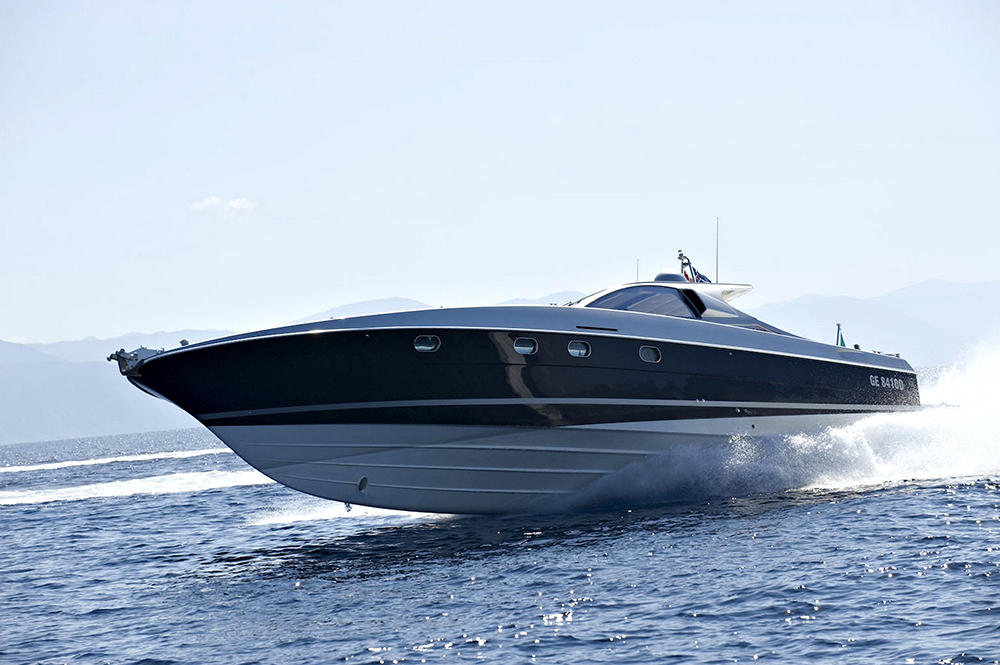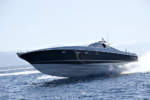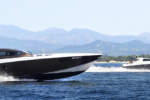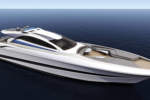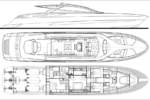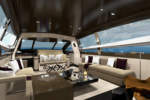Marco Casamonti: When was the Otam yacht building yard founded, how has it developed, what is its philosophy and its history?
Gianfranco Zanoni: The Otam boat yard was founded in 1954 in Margherita Ligure as a service centre for boats. It has then developed and become the property of Carlo Riva, and thus specialized in Riva boats.
The yard has subsequently begun to build its own boats, and then in the Eighties when it was sold by Carlo Riva to the new owner, this has resulted in the possibility to fit out Magnum boats which were built in the United States and, after the installation of the engines, sent to Santa Margherita for the realization of the interiors. In 1995 Otam decided to build an own boat, obviously inspired by the Magnum. All the weak points were analysed, from the rather Spartan lamination to the fact that they were completely open boats, in an attempt to create a better product from every point of view: from the design, to the engine room, to the engines to the interiors and the hard top. In 1995 Otam thus decided to build first the 45; and in 1998 it immediately proceeded with the 58, a boat with a hard top that made it possible to cover long distances without great problems, but that at the same time remained an open boat. It is a matter of a fast, fascinating boat, vaunting clean but very aggressive lines and great seaworthiness.
Until this point, however, the interiors were a bit old-fashioned. Then we have made a great leap ahead in terms of design quality in 2009, with architect Salvagni.
M.C.: Does the customer entrust the work to your architect or to your designer?
G.Z.: Our typical customer already knows how he wants the boat; he only needs someone to put the ideas onto paper, to turn them into a project.
Carlo Pezzoli: With Salvagni we have begun to suggest possible interior arrangements to the customer, which may be customized both in terms of materials and layout; Salvagni has contributed to modernize our designs a lot. And if Riva represents elegance par excellence, and Magnum performance, we have tried to combine the two, elegance and performance.
M.C.: What and how many figures are necessary to take a project from beginning to end?
G.Z.: We work with the Tagliavini firm, which provides for all the hydrodynamic studies of the hull. As to the superstructure, we have always wanted a very aggressive boat, and we have therefore previously entrusted this work to Paolo Martin who is very well known in the car sector, and then more recently to a very capable youth, Alberto Mancini of Trieste, who has suggested the solutions of the hard-top of the 65 and the covered design of the 100. We therefore have a firm for the hulls, one for the superstructures, and then a firm, headed by architect Achille Salvagni, that takes care of the interiors.
M.C.: Does a supplier build the hull, which arrives unfinished, and do you then proceed to install the engines?
G.Z.: We have our boat moulds with a company; then we provide them with our moulding specifications as specified by the Tagliavini firm, and we have a technician in charge of controlling and assisting with the building of the boats according to our instructions. The customer chooses a layout, which must however be subjected to a structural analysis. When this is done we forward the layout to the our technician who provides for positioning the structural bulkheads; when the lamination process is finished the boat arrives with the hull already divided into bulkheads and with the deck installed, and we install all the systems, the engines, the generators and accessories, and construct the interior furniture on board; I believe we are the last to do so.
M.C.: As to the technological aspects, you build some boats also in Kevlar, and others in Aramat. What are the differences?
G.Z.: A boat made principally in Aramat – high performance fibreglass – costs about 22 euro per kilo, while the part in Kevlar-enriched resin of a boat costs 36-37 euro per kilo. Kevlar is much lighter, it has a very high resistance to traction but not a very good one to compression, and we therefore often use Aramat, because fibreglass is very resistant to both compression and traction, and when bound with Kevlar fibres the characteristics are accentuated.
M.C.: The themes of ecology, sustainability and ecocompatibility are becoming relevant to all sectors; for instance also Ferrari, at the last World Expo, presented a model with KERS (Kinetic Energy Recovery System). Do you who operate in the boating sector also observe this request on the part of the customers? Do they demand a product that not only vaunts a high performance, is very sportive and fast, but also pays attention to environmental issues?
G.Z.: We are currently doing research on weight reduction, by producing two hard tops completely in carbon, which makes it possible to reduce the weight from 470 kilos to 170 kilos for the model 58, while the 780 kilos of the 65 model should according to the plans become 250 kilos. We want to reduce the weight and thus the power, to be able to always have the same performance while reducing consumption. The first step is therefore a reduction of the weight, while the second is to integrate the electric system to be used… especially when entering the harbour.
We do not believe much in photovoltaic, as we do not have enough space.
M.C.: However, the theme of the hybrid is interesting. But is it really feasible or is it a matter of science fiction?
G.Z.: It is feasible, and would already have been realized, strange as it may seem, if they had not resumed using KERS in formula 1. In fact, the various companies which have studied KERS or recovery of energy when braking, have developed very compact, small and powerful engines. Then KERS has been banished and the companies have looked for other solutions. We were studying an application to boats, and specifically to our ones, with one of these companies, but once KERS returned in vogue all the companies have returned to work with Formula 1.
M.C.: The theme of acoustic comfort, especially in a very fast boat with a very high performance and very powerful engines, is important…
G.Z.: We have installed an engine hood that we open hydraulically to show the whole engine room, which is fully acoustically insulated, we have installed o-rings around all openings and it becomes completely hermetic when the engine hood is closed.
M.C.: Engines with water jet instead of propellers have been seen, also in boats with a high performance. Is it a matter of a passing idea, or is it something feasible?
G.Z.: The answer is no, it cannot be done with sports boats, principally because water jet has a limit, in terms of performance, of 48 knots.
It is a problem of efficiency of the jet which thrusts against another mass of water in order to move the boat, and that cannot go beyond 48 knots. A fast boat is also designed to leap between the waves; when it shots out of the wave the jet no longer sucks water, and the boat drops like a stone because it no longer has a thrust.
M.C.: These boats are very seaworthy, because they are very long, very narrow, very V-shaped…
G.Z.: Speed and seaworthiness is the philosophy on which basis OTAM has created its fleet. We have therefore designed hulls with a very accentuated V-shape, that makes it possible to achieve an outstanding performance; powerful engines guarantee a high speed and our 21-degree stern assure greater stability and comfort, because the stress from the water is distributed according to the deadrise angle.
Gianfranco Zanoni is engineer and CEO of OTAM
Carlo Pezzoli is Sales Manager of OTAM


